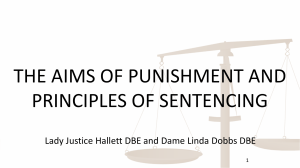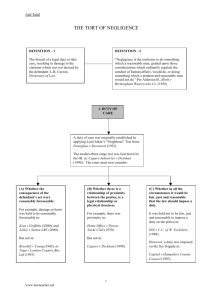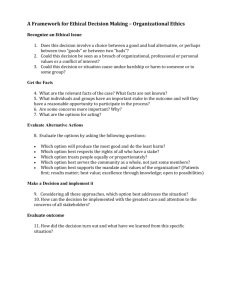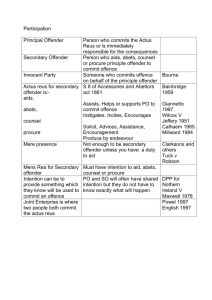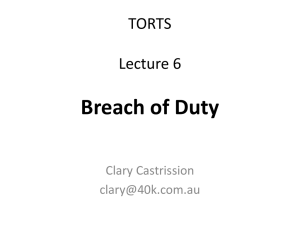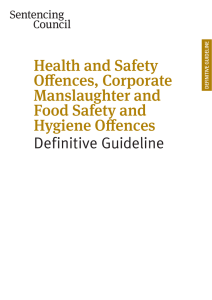View Here
advertisement
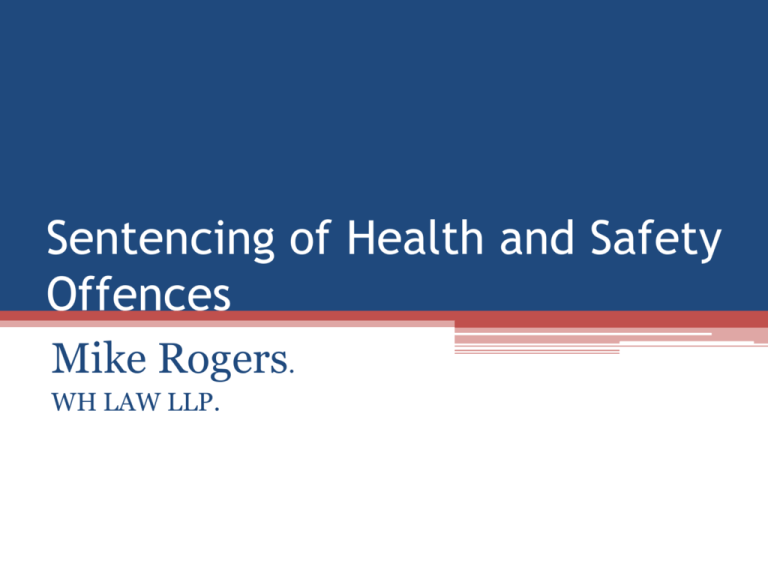
Sentencing of Health and Safety Offences Mike Rogers. WH LAW LLP. The Statutory aims of sentencing Criminal Justice Act 2003, section 142(1) “Any court dealing with an offender in respect of his offence must have regard to the following purposes of sentences – a. the punishment of offenders, b. the reduction of crime (including its reduction by deterrence), c. the reform and rehabilitation of offenders, d. the protection of the public, and e. the making of reparation by offenders to persons affected by their offences.” Guidelines • No tariff that gives a defined minimum or maximum sentencing guide as in criminal cases • Sentences are determined on a case by case basis • Early guilty pleas are taken into account and in the crown court an indication of a sentence will be given when an early guilty plea is entered. Seriousness of offence • Seriousness of offence dictates the appropriate level of sentence. • Determined by individual circumstances of the case and Sentencing Guidelines Council guidelines on seriousness. • Culpability (blameworthiness) of the Defendant and Harm caused or might have been caused. Factors • Aggravating and mitigating factors that contribute to sentencing decision • Facts of case examined to decide the degree of culpability and harm • Non-exhaustive list first laid down by R v F Howe & Son (Engineers) Ltd 1998. Factors which may indicate higher than usual culpability 1. Offence deliberate or reckless breach of law rather than result of carelessness 2. Action of lack of action prompted by financial motives (profit or cost-saving) 3. Regular or continuing breach, not isolated lapse 4. Failure to respond to advice, cautions or warning from regulatory authority and/or ignoring concerns raised by employees or others. Factors which may indicate higher than usual culpability 5. Offender has committed previous offences of a similar nature. 6. Offender exhibited obstructive or dismissive attitude to authorities. 7. Offender carrying out operations without an appropriate licence. Factors which may indicate greater than usual degree of harm 1. Death or serious injury or ill-health resulted from or risked by offence 2. High degree of damage resulting from offence 3. Still serious if damage does not occur but risk is still present 4. Considerable potential for harm to workers or public Factors which may indicate greater than usual degree of harm 5. Animal health or flora affected 6. Extensive clean-up operation or other remedial steps required 7. Other lawful activities interfered with Factors which may indicate lower than usual culpability 1. Offender played a relatively minor role or had little personal responsibility 2. Genuine and reasonable lack of awareness or understanding of specific regulations 3. Isolated lapse Matters of offender mitigation Offender’s prompt reporting of offence and ready co-operation with regulatory authority. Offender took steps to remedy the problem as soon as possible. Good previous record. • Mitigation =the action of reducing the severity, seriousness, or painfulness of something Relevant factors Court decide whether these apply and if they are aggravating or mitigating • Degree of risk and extent of danger • Gravity and extent of the breach • Isolated period or continued over a period • Defendant’s resources and the effect of the fine on its business R v F Howe & Son (Engineers) Ltd 1998 An accident occurred at the appellant company's premises in which a young man was electrocuted. The cause of the accident was a damaged cable connecting a cleaning machine which was being used to collect water. The cable became trapped under the machine which became live as a result. The cable had been plugged into a socket in which the fuses had been bridged with fuse wire, and a Residual Current Device which should have tripped the current had been by-passed. R v F Howe & Son (Engineers) Ltd 1998. Aggravating Factors • Death resulted from the breach • A failure by the Defendant to heed warnings such as HSE advice, enforcement notices, or concerns raised by employees or others. • A deliberate breach with a view to profit or a risk run specifically in order to save money. R v F Howe & Son (Engineers) Ltd 1998. Mitigating Factors Prompt admission of responsibility and a timely plea of guilty. Steps taken to remedy the deficiencies after they were drawn to the Defendant’s attention. A good health and safety record i.e. no previous convictions in health and safety matters, no improvement or prohibition notices having been served on the defendant, and evidence that the defendant has, in the past, followed HSE advice when it has been given. R v Fresha Bakeries Ltd. 2002. • Grate needed removing from an industrial bread oven • Sought to be resolved inhouse • Two employees crushed and died of injuries and heat exhasution • Oven turned off but still at temperature of 100C with employees trapped inside for 17 minutes Aggravating Factors System devised fell far below a reasonably safe system of work. Death or really serious harm was inevitable. Loss of two lives. No risk assessment which would have revealed inadequacies. Lack fo appropriate training, planning, monitoring and supervision at all levels. Mitigating Factors Early Guilty Pleas entered Major efforts made after the event to deal with health and safety No previous convictions for Health and Safety offences £350,000 fine and £145,000 costs to businesses involved Total of £3,000 fines against two senior individuals in organisations Corporate Manslaughter Organisation guilty if the way its activities are managed or organised: • Causes a persons death • Amounts to a gross breach of a relevant duty of care by the organisation to the deceased and the way its activities are managed and organised by its senior management is a substantial element in that breach Three important components of offence a) Relevant duty of care b) Gross breach of duty c) Senior Management • turn Lets consider these three components in Duty of Care Any of the following duties owed by an organisation under the law of negligence:1. A duty owed to the employee or others 2. A duty owed as occupier of premises 3. A duty owed in connection with the supply of goods/services or carrying on of construction or maintenance operations or the carrying on of any other activity on a commercial basis Gross breach of care Conduct alleged to amount to a breach of a relevant duty is gross if it falls far below what can be reasonably expected of the organisation in the circumstances. Seriousness, risk, attitude to Health and Safety and any other relevant matters are considered. Senior Management • Persons who play significant roles in decision making in the management or organisation of the organisation’s activities. and • Those who actually manage and organise the whole or substantial part of the activities Sanctions • Fine • Publcitity order - “name and shame” • A remedial order • Failure to comply punishable by a fine Example • Factory hire independent contractors to renovate business premesis. • Minimal supervision popped in every few days • Placed Roofer in dangerous conditions • Fell from roof and died from injuries “Business owner” • In the event of a death the police will become involved in the initial process which will mirror that of criminal proceedings. • Being a “factory/business owner and not a criminal” will not exempt those responsible from the process and an interview under Police and Criminal Evidence Act 1984 will be conducted. Interview • In this example the factory owner was told that they were not under arrest but • They were taken into the custody block where all criminals arrested in the area were booked in and held. • They were interviewed by a Detective Constable in a process that lasted a total of 14 hours Safeguard This experience, regardless of intent or criminality is the process that a person can go through even in the course of their duties as a factory/business owner and putting the correct and appropriate safeguards (policies, procedures and control measures) in place to prevent such an ordeal will prevent this and the harm, or risk of harm, to employees.

